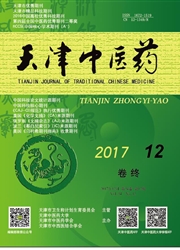

 中文摘要:
中文摘要:
[目的]通过免疫印记法检测实验性Ⅱ型糖尿病大鼠下肢股血管中Toll样受体-2(TLR-2)、Toll样受体-4(TLR-4)表达,并通过观察桃核承气汤对相关指标影响,揭示糖尿病大血管纤维化病变的发病机制,及中药桃核承气汤在糖尿病血管纤维化中的干预作用。[方法]雄性SD大鼠170只,随机分为5组:A-正常对照组(n=30),余140只造糖尿病模型模,造模成功123只,随机分为4组:B-模型对照组(n=31)、C-中药高剂量治疗组(n=30)、D-中药中剂量治疗组(n=31)、E-中药低剂量治疗组(n=31);A组不予药物干预,B组每日给予0.9%生理盐水10 m L/kg灌胃,C组每日给予桃核承气汤1.8g/kg,D组每日给予桃核承气汤0.9g/kg,E组每日给予桃核承气汤0.45g/kg。药物干预第1周、12周、20周,按计划处死大鼠,各组分别取材,保存标本,免疫印记法检测TLR-2、TLR-4沉积部位及表达情况。[结果]TLR-2、TLR-4在糖尿病大鼠股动脉中均显著表达,中药桃核承气汤干预可有效降低TLR-2及TLR-4的表达。[结论]糖尿病大血管病变可能与Toll样受体通路有关,中药组方桃核承气汤对糖尿病大血管病变有明显改善作用,可减缓纤维化进程,其干预作用于用药剂量和用药时间相关。
 英文摘要:
英文摘要:
[Objective] Using Western blotting to detect the expression of TLR-2, TLR-4 which from the diabetes rats in lower limb femoral vessels, and observing by Taohe Chengqi Tang(THCQT) impact on related indicators, revealing intervention mechanisms of THCQT on diabetic vascular fibrosis. [Methods] The 170 male SD rats were divided into five groups, A- the normal control group(n=30),other 140 making diabetes model and succeed 123, randomly divided into 4 groups:B- model control group(n=31), C- Chinese high-dose treatment group(n=30), D-medicine dose treatment group(n=31), E- low dose treatment group(n=31). A group was no drug intervention,group B received 0.9% saline 10 m L/(kg·d) orally, group C was given THCQT 1.8 g/kg, D group was given THCQT 0.9 g/kg, E group was given THCQT 0.45 g/kg. Drug intervention first weeks, 12 weeks, 20 weeks, the rats were sacrificed according to plan, the groups were drawn, preserved specimens, Western blotting detection TLR-2 and TLR-4 expression. [Results] TLR-2 and TLR-4 has significant expression in diabetic rat femoral artery, TCD THCQT can effectively reduce the expression of TLR-2 and TLR-4. [Conclusion] Diabetic vascular disease may be associated with Toll-like receptor pathway and apoptosis, TCD THCQT can obviously improve diabetic vascular lesions, and slow down the fibrosis process, its intervention effect associated with dosage and duration.
 同期刊论文项目
同期刊论文项目
 同项目期刊论文
同项目期刊论文
 期刊信息
期刊信息
